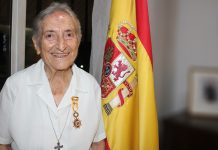Rome (Italy). June 24, 2021 marks the 70th anniversary of the canonization of Mary Domenica Mazzarello, Co-founder with Don Bosco of the Institute of the Daughters of Mary Help of Christians, proclaimed a Saint by Pope Pius XII on 24 June 1951, in St. Peter’s Basilica at the Vatican in Rome.
Sr. Piera Cavaglià, Secretary General of the FMA Institute, in the meeting with the FMA Community of the Generalate in Rome (RCG), presenting the process of the Canonization of Mother Mazzarello in view of the 70th Anniversary highlighted, “The Holiness of Mother Mazzarello was a sign of great blessing for the whole FMA Institute and for the Church, but also a call to strive ‘for the high standard of ordinary Christian life’” (Cf. John Paul II, Novo Millennio Ineunte 31).
In giving the news to the FMA Institute about a month earlier, the Vicar General, Mother Elvira Rizzi, on behalf of the Superior General of the FMA Institute, Mother Linda Lucotti, wrote, “Dear Sisters, speak to everyone about this joy of our religious family, spread the news to all classes of people” (Circular of 4-5-1951).
24 June 1951 in St. Peter’s Basilica, Mother Linda Lucotti with the General Council, 32 Provincials from Italy, Europe, America, and the Middle East; 3,000 FMA among Animators, Sisters, Novices, Postulants, Aspirants, girls, parents are present, and Past Pupils of the FMA and the Salesians of Don Bosco, Salesian Cooperators, and pilgrims from all over the world; and the two miracles through the intercession of Mother Mazzarello for Sister Maggiorina Avalle, FMA, and Carla Ramponi, from Castano Primo (Milan).
The banner of the Saint, the work of the painter Gian Paolo Crida, opens the papal procession with the Supreme Pontiff Pius XII accompanied by the college of Cardinals, Prelates, and Officials of the Roman Curia, Abbots, Bishops, Archbishops head to the Altar of Confession. On the pediment of the external Loggia of the Basilica there is the tapestry with the two Saint educators canonized on that day: Mary Mazzarello and Emilia de Vialar, Foundress of the Institute of the Sisters of St. Joseph of the Apparition.
Journey of the Canonization Process
The reputation of holiness, indispensable for starting the Canonization Process, was alive among the Sisters, the missionaries, but also among the Salesians of Don Bosco, and the people who had known her. There was trust in her intercession and the FMA felt they had had a Holy Superior.
There are two main stages of the Process regarding the collection and examination of documentation: the Diocesan Information Process, set up by the Diocese in which the person dies with a reputation for holiness, and the Apostolic Process, called by the Sacred Congregation of Rites. Between the two processes is the Decree for the introduction of the Cause (27 May 1925), which is followed by a discussion on the virtues (Decree of Venerability), and on the miracles (Decree of Beatification and Canonization).
The Diocesan Information Process began in the Curia of Acqui Terme (AL) on 23 June 1911. Fr. Ferdinando Maccono was chosen as Vice-Postulator of the Cause. Maccono worked with accuracy, seriousness of historical method, and literary ability to make Mother known and loved. In 1918, Cardinal John Cagliero, SDB, was appointed as Relator of the Cause (ponente), a very significant figure due to his long familiarity with Sister Mary Mazzarello.
Between 1918 and 1924 the Process on the writings of Sister Mary Mazzarello was carried out. In the letters collected and authenticated by the Curia of Acqui, one of the theologians highlights the ‘singular care’ for the formation of her sisters, her humility, and her ardent love for Jesus, the only purpose of her life.
For the testimonies, 27 people were questioned: many FMA, received as boarders in the School of Mornese or as postulants, among them Caterina Daghero, Enrichetta Sorbone, Eulalia Bosco; some ladies, including some past pupils from the workroom; some Daughters of the Immaculate Conception; lay people, including cousins Giuseppe and Domenico Mazzarello; three Salesians, Msgr. John Cagliero, Msgr. James Costamagna, and Fr. Francesco Cerruti. One of the most significant witnesses was Sister Petronilla Mazzarello, the friend with whom Mother Mazzarello shared the project for the education of girls and the gradual establishment and consolidation of the FMA Institute.
In 1923 the Litterae Postulatoriae were collected, in which it asked that Sister Mary Mazzarello be raised to the honors of the altars. The letters collected were 558, coming from various parts of the world, demonstrating her popularity.
In 1925 the Apostolic Process began.
In 1929 in Nizza was the recognition of the body in the presence of doctors and competent people. In 1934, on the question of the title of ‘Co-founder’ attributed by the Church to Mother Mazzarello.
In 1935, the decisive phase of the Process was entered: the evaluation of the heroic nature of the virtues and confirmation with miracles. Two miracles were presented: the first occurred in 1916, with the healing of the little girl Ercolina Mazzarello, resident of Mornese, who suffered from acute spinal paralysis in both legs due to polio. The second, on 19 March 1926, with the healing of the twelve-year-old Rosa Bellavita from Paullo (Milan), suffering from ascitic tuberculous peritonitis. In both cases they are instantaneous, complete, and lasting healings, unexplained from a scientific point of view.
On 3 May 1936, in the Consistory Hall, in the presence of Pope Pius XI, there was the reading of the Decree of the heroic virtues (Venerability), the foundation for a process of beatification. Her remains were brought from Nizza Monferrato (AT) to Turin, provisionally placed in the Chapel of the relics, waiting to be placed in the Basilica of Mary Help of Christians.
On 20 November 1938 at Roma, in St. Peter’s Basilica in the Vatican, the solemn Beatification was held, attended by the two young women who were miraculously cured: Ercolina Mazzarello, who was 26, and Rosa Bellavita, 24. Pope Pius XI was offered a reliquary with the vertebra of Mother Mazzarello and he commented: “Mazzarello, as Don Bosco had a good backbone. Tell the sisters they too must have a good backbone”.
The Process in view of the Canonization resumed in 1941. The cult of Blessed Mary Domenica Mazzarello bore this popular imprint: “It is the people who go to her; they feel she is a Saint who understands, who listens, helps with predilection the people of her condition,” wrote the Bishop of Asti, Msgr. Umberto Rossi.
On 13 March 1950, in the presence of Pope Pius XII, the decree for the approval of miracles was read: Sister Maggiorina Avalle, FMA, recovered instantly in Roppolo Castello (Biella), 15 August 1941, from widespread septicemia, when the doctors said that she had only a few hours left to live; and Carla Ramponi from Castano Primo (Milan), recovered on 24 November 1946, at the age of 8, of acute nephritis, after an FMA had placed under the head of the child who seemed dead, the relic of Mother Mazzarello.
On 24 June 1951, the canonization of St. Mary Domenica Mazzarello was proposed for the cult of the Universal Church. The Bull of Canonization ends with an exhortation addressed to everyone, especially the FMA of whom Mother Mazzarello was the first Superior: “May they learn from her the only true science, which, as she wrote, consists in making ourselves saints”.
Celebrating a Canonization Anniversary means keeping alive the memory of the events of grace and the bonds of communion; it is to continue “to recognize that we are surrounded by a multitude of witnesses who urge us not to stop along the way, stimulate us to continue walking towards the goal” (Pope Francis, Gaudete et Exsultate, n. 3).




















